‘War is hell’ announced General William Tecumseh Sherman in an address to the graduating class of the Michigan Military Academy in 1879.
And I don’t think any of us would disagree, whether we have fought in, lived through, or had knowledge of such conflict, no matter how large or small. The odd thing though, is that during these times of strife, the human race seems to be at its most creative and innovative.
The inherent creativity used to create weapons of destruction is astounding. The last century, in particular, has seen the most obscene and efficient methods invented.
We have recently remembered the centenary of the outbreak of the ‘War to end all Wars’; except for the one that followed it, and the next and so on…
This year’s Armistice Day also marked the centenary of the end of fighting in the First Battle of Ypres (although German history say it was a couple of weeks later). The battle is known as the ‘Massacre of the Innocents of Ypres’ for the number of young men killed or wounded. During that one six-week battle more than 300,000 men were reported as killed, wounded or missing. Many of them were students who had not even reached their 20th birthday; whole generations tragically lost.
And if that killing spree wasn’t enough, the next four years saw more than 37 million killed, missing or wounded and a raft of technological advances that were created with one purpose in mind: the machine gun, flamethrower, tank, fighter and bomber aircraft and gas; all designed for the destruction of flesh and bone.
New terms and expressions, now so familiar, entered the vocabulary: washed out, pushing up the daisies, snapshot, gaff, snuffed it, swipe, blind spot, barrage, strafing and my personal favourite thingamajig (used to describe some of the unnamed moving parts of the emerging killing technologies).
Those that fought in the First World War have now passed. But many of us will know of a relative or friend, living or dead, who served their country in that, or subsequent, conflict. Many of those rarely talking about their experiences and the horrors they witnessed.
Rightly or wrongly we still get drawn into conflicts that put our servicemen, and women, in the line of fire.
And, as in any conflict, there are casualties. The tragic deaths highlighted in public displays of sympathy every time a serviceperson is repatriated at Royal Wootton Bassett.
But many more come back injured both physically and mentally; many harbour hidden, unseen wounds. It is not really surprising that some of these returning troops turn to drugs or alcohol as a way of ‘coming to terms’ with their experiences of war and their return to good old ‘Blighty’ (another WWI term).
A recent MOD-funded survey of 10,000 current and recent service personnel showed that 22 per cent of those that had served in Iraq or Afghanistan admitted to excessive drinking compared to only 13 per cent who had not carried out tours of duty in those places
Random drug-testing by the military has meant the use of illegal drugs being used has decreased, and alcohol use while on active duty is prohibited. But this has led to some turning to NPS (New Psychoactive Substances) ‘legal highs’ as they are not traceable in tests. Others have turned to increased use of prescription drugs; in both cases to relieve the boredom of being confined to barracks, and the fear of a possible insurgent attack at any moment.
Although help and support is offered by the military, how many men and women, ‘toughened up’ by arguably the best training in the world, cannot or will not come forward for fear of the stigma associated with their issues?
Those that do reach out for help, and receive it, are the lucky ones. But for some the wounds and scars remain invisible. According to the charity Combat Stress a veteran will take, on average, 14 years before approaching them for help about Post Traumatic Stress Disorder (PTSD), and during that time many have fallen in to drug or alcohol misuse problems.
But this need not be the case.
We all have the Power to Create. The power to make change. Power to create a peaceful, harmonious, tolerant and compassionate connected community in which to live; where people with addiction, mental health issues, disabilities, different sexualities, ethnicities, beliefs and customs are embraced and helped without fear of stigma, persecution and isolation (locally, nationally and globally).
It’s the right of every person on the earth.
It is something we must never forget.
It is something many fought and died for.
And the best way to honour their memory is to use the Power to Create to make a positive difference.
‘They shall grow not old, as we that are left grow old:
Age shall not weary them, nor the years condemn.
At the going down of the sun and in the morning.
We will remember them’.
Lest we forget.


Be the first to write a comment
Please login to post a comment or reply.
Don't have an account? Click here to register.